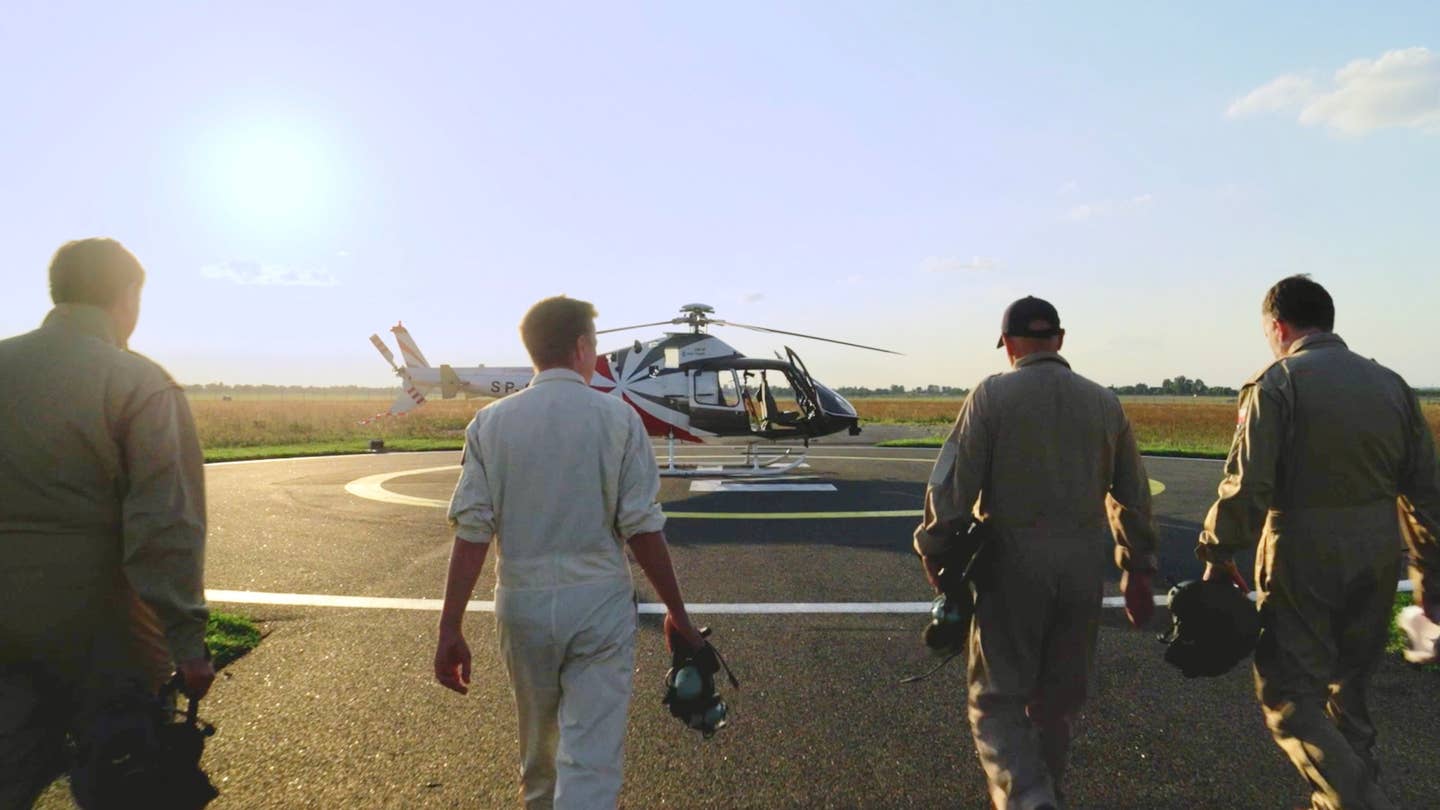Leonardo Tests AI-Enabled Visual Awareness System for Rotorcraft
The manufacturer collaborates with artificial intelligence provider Daedalean on a yearlong trial using its SW4 and SW4 Solo RUAS/OPH helicopters.

Test pilots walk toward a Leonardo SW4 helicopter equipped with Daedalean’s visual air traffic detection system. [Courtesy: Daedalean]
Leonardo, one of the world’s largest manufacturers of rotorcraft, believes artificial intelligence (AI) could be a game-changer for civil aviation.
The Italian firm and Daedalean, a Swiss developer of AI systems for situational awareness and flight control, on Monday announced they completed a flight test campaign that evaluated AI capabilities for advanced navigation of rotorcraft.
Daedalean’s AI-enabled visual awareness system was installed on Leonardo’s SW4 and SW4 Solo RUAS/OPH (Rotorcraft Unmanned Air System/Optionally Piloted Helicopter) models, which flew out of the manufacturer’s PZL-Świdnik facility in Lublin, Poland. PZL-Świdnik is the largest helicopter production plant in the country.
Daedalean claims its PilotEye visual traffic detection system will be the first AI-based cockpit application to be certified for civil aviation. The company is looking to serve general aviation, commercial air transport, urban air mobility (UAM), and uncrewed air vehicles (UAVs).
The Swiss company will certify its neural network-based system with both the FAA and European Union Aviation Safety Agency (EASA). The FAA has released an Issue Paper for the technology, while EASA has issued a Certification Review Item, to get the ball rolling.
“Leonardo is working towards prudently integrating AI in its products and services through both in-house developments and cooperations,” said Mattia Cavanna, head of technology and innovation at Leonardo Helicopters. “By collaborating with emerging companies on predefined use cases, we keep maturing our technology road maps towards a safer, affordable, and sustainable flight experience. Improving situational awareness…could contribute to further prevent aviation accidents and progressively enable higher degrees of autonomy to our platform.”
Daedalean and Leonardo collaborated on the yearlong project under a grant from Eureka Eurostars, the largest international funding program for small- and medium-sized enterprises (SMEs) looking to partner on R&D projects.
The partners equipped Leonardo helicopters with Daedalean’s aircraft-mounted cameras, computer, and interface display. Testing ran from July to September 2023. According to its analysis, Leonardo said the campaign delivered “outstanding results.”
“Daedalean is proud to bring our experience creating machine-learned algorithms for aviation to such a prominent player in the world of aviation,” said Luuk van Dijk, CEO of Daedalean. “It shows there is growing interest in and understanding of the benefits machine learning can bring today to increase flight safety.”
Daedalean provides what it calls “situational intelligence,” or the ability for an aircraft to understand its environment and anticipate and react to potential threats. Its visual awareness system uses machine learning to quickly and effectively perform tasks the company said previously could only be done by humans.
The company’s PilotEye solution can identify aerial traffic—including ADS-B-equipped aircraft as well as “non-cooperative traffic” such as birds or drones—determine an aircraft’s location in GPS-denied environments, and even offer landing guidance.
PilotEye represents a joint project between Daedalean and Avidyne Corp., a provider of integrated avionics systems, flight displays, and safety systems for GA and business aircraft. The system integrates with Avidyne’s Skytrax Traffic Advisory System into the IFD5XX flight display series.
Daedalean is also collaborating with Xwing, a fellow developer of automated flight systems, to harmonize their approaches to certification and speed the approval of both companies’ technology. Further, it has conducted joint research with the FAA, EASA, and other regulators to demonstrate that its system can be certified under stringent safety standards.
“Daedalean published multiple studies with regulators to evidence the fact that our machine-learned algorithms are capable of providing functions meeting and exceeding human capabilities,” van Dijk said. “As aviators and passengers become more familiar with AI-enabled systems, a future with autonomous flight becomes more attractive for the higher safety, lower cost, and increased capacity it will deliver.”
Leonardo, meanwhile, said it is “well positioned” to possibly retrofit its line of aircraft with Daedalean tech and is eyeing integration on future models.
The manufacturer has a network of research and development laboratories called Leonardo Labs, which serve as technology hubs connecting university talent with company experts. The sites are intended to drive innovation, uncover practical applications, and research areas such as materials and quantum technologies, sustainability, and applied artificial intelligence.
Other Leonardo projects under development include fuel-reducing technology, a tiltrotor airframe design, and a search and rescue helicopter.
Like this story? We think you'll also like the Future of FLYING newsletter sent every Thursday afternoon. Sign up now.

Subscribe to Our Newsletter
Get the latest FLYING stories delivered directly to your inbox






